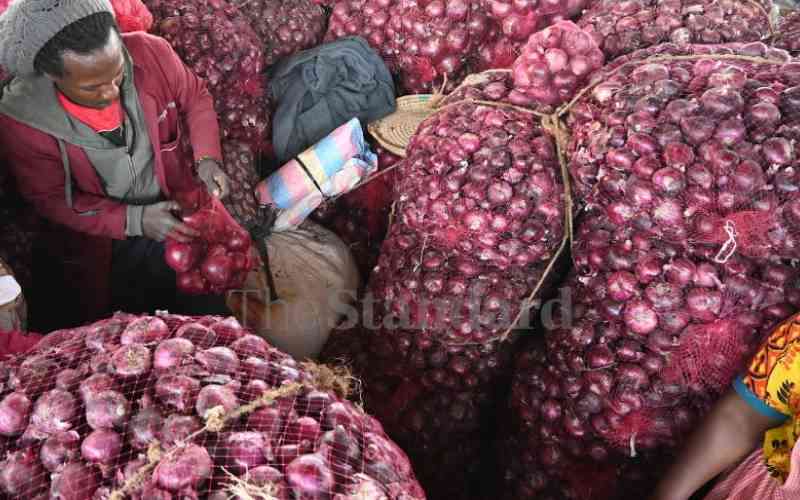The price of onions will continue rising across the country due to low local production and reduced imports from Tanzania.
This has caused a biting shortage of the commodity with prices tripling.
This comes after farmers in Nyeri County – one of Kenya’s largest onion-growing regions – failed to plant the crop last year due to low rainfall.
This, coupled with taxes imposed on imports from Tanzania, has created an acute shortage of onions with 1kg of the commodity selling at Sh150 and a 40kg sack retailing at Sh5,600.
Four months ago, the price of the same commodity was Sh50 per kg, while some wholesale traders would sell at Sh30.
Traders at the open-air market in Nyeri said the shortage of onions has left them without stocks of the commodity with nowhere to source it.
“Even in our neighbouring country Tanzania, most onion farmers shifted to maize when the cost of flour increased, leaving a big gap,” said Nahashon Ngatia, an onion trader for the last 14 years.
Farmers and traders from Kiawara, an area key onion-growing area in Nyeri, faced a similar scenario.
Joseph Wambugu, a farmer at the Kiaragana and Kimunyuru areas in Gatarakwa, Kieni West attributed the shortage to farmers abandoning onion farming for other crops such as wheat maize, cabbage, and potatoes.
“For almost two years, the price of onion was as low as Sh20 to Sh30 per kg, and sometimes the farmers sold them at a throw-away price, and this discouraged onion farming,” he said.
Wambugu said the cost of onion production is too high compared to the profit.
“The cost of growing onions on one acre of land is approximately Sh100,000, “ Wambugu said, adding that such acreage can produce from seven to 10 tonnes per harvest.
“Currently, the cost of seedlings is high with 500 grams of Lucet onion seedlings costing Sh17,000. The cost of labour, pesticide and fertiliser has also increased due to market forces,” he added.
He said low rainfall has also affected production since there has been a dry season for a while, and most of the farmers rely on rain-fed agriculture.
“In mid-June, onions from Tanzania flooded our markets. This season there was no importation since onion farmers in Tanzania shifted to other crops, including maize and wheat, forcing the prices to go up,” Wambugu said.
Mary Wangechi, a wholesale trader at Kiawara, said that after two years of low prices they have gone up 10 times.
“Barely two months ago, we sold onions at a throw-away price of Sh30, and now we sell at Sh130 per kg, but most of the onion farmers who are our suppliers have abandoned the crop due to loss incurred earlier,” she said.
She said onions are planted in September and harvested in December by most farmers who depend on rain-fed agriculture, but those who embrace irrigation can plant throughout the season.
She insisted the onion from Tanzania failed to reach the market this year, adding that imposed taxes on imports have discouraged traders from the neighbouring countries.
A spot check at Kiawara market along the busy Nyeri-Nyahururu highway showed little or no business, as most traders opted to close their business due to a lack of onions, which is their main selling commodity.
Antony Ndirangu, a farmer at Kiaragana, said the shortage may extend for two to three months since most farmers have started to plant the crop.
Wambugu Farm Agriculture Training Center Crop development officer, John Wambugu, observed the shortage in the market was due to low supply as farmers shifted to other crops.
“Farmers should plant high quality of the seed and practice irrigation-fed agriculture instead of rain feed to maximise yields,” he said.





















Discussion about this post